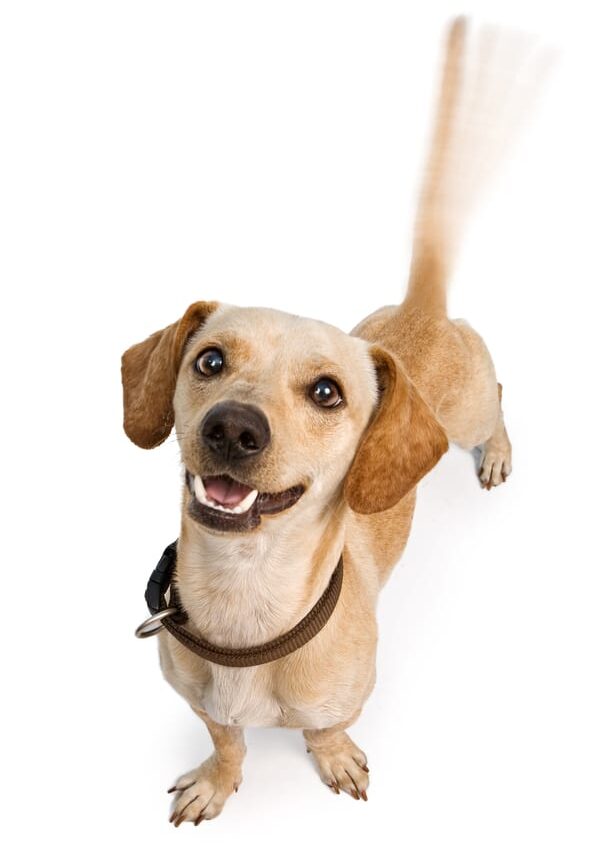We have all heard the common myth that a wagging tail means a happy, friendly dog. While it is true that dogs do wag their tails to express happiness at seeing a person (or dinner!), dogs also wag their tails to show other emotions. In fact, dog tails are more like human faces, showing their emotions through movement and position much like we do with smiles, frowns, pursed lips, etc.Knowing what to look for in a dog’s tail can help you determine if you should approach the dog or stay away, avoiding potential harm. It can also let you know if your dog is in danger of getting attacked by an oncoming dog before they are near enough to hear them growl, giving you more time to get away. But, it’s not as easy as it sounds.

Tail Signals
Dr. Stanel Coren, Ph.D., F.R.S.C, Professor Emeritus, Department of Psychology at University of British Colombia, has researched and written several books on dog psychology including How to Speak Dog, The Intelligence of Dogs and the award-winning Born to Bark. Dr. Coren’s research has found that dogs do indeed use their tails to communicate more than just happiness; and like most ways of communication, dogs do not wag their tails when they are alone (unless a ball or something catches their attention through movement).
In general, a low slung tail signifies fear or anxiety; a mid-set tail means the dog is calm or “neutral”; a high-set or straight-up tail means the dog is alert or aggressive. Couple these with tail movement, and other dogs are able to know exactly what your dog is feeling, even from a distance.
They have found the following combinations are some of the most common dog owners will see:
- A slight wag-with each swing of only small breadth-is usually seen during greetings as a tentative “Hello there,” or a hopeful “I’m here.”
- A broad wag is friendly; “I am not challenging or threatening you.” This can also mean, “I’m pleased,” which is the closest to the popular concept of the happiness wag, especially if the tail seems to drag the hips with it.
- A slow wag with tail at ‘half-mast’ is less social than most other tail signals. Generally speaking, slow wags with the tail in neither a particularly dominant (high) nor a submissive (low) position are signs of insecurity.
- Tiny, high-speed movements that give the impression of the tail vibrating are signs the dog is about to do something-usually run or fight usually. If the tail is held high while vibrating, it is most likely an active threat.
Does Breed Make a Difference?
Since different breeds have natural tail carriages that vary, a person should always be aware of the breed of dog they are assessing before reading its tail. For example, Greyhounds tend to carry their tail fairly low, in a position that would signal nervousness in a Lab, while Jack Russell Terriers carry theirs almost straight up, a sure sign of over-arousal or alertness in my own Shetland Sheepdog. This means you have to know your breeds fairly well before you can even think about using the dog’s tail as a way to read their emotions.
The other interesting research that has been done is on docked tails. Large dogs with tails less than six inches long, tend to have a hard time communicating correctly with other dogs. Dr. Coren carried out an observational experiment where he observed dogs at a dog park interacting with each other. What he found was that while only 24% of the dogs did not have tails, 53% of the confrontations witnessed involved a dog without a tail. In order to take out the possibility of breed temperaments being the cause (as many docked breeds were bred for protection/guarding), Dr. Coren created a robotic dog that could have both a long and a short tail. When the short tail was in place, dogs were wary about approaching the dog, even when it was moving in the traditional signs of greeting. (http://www.psychologytoday.com/blog/canine-corner/201202/long-tails-versus-short-tails-and-canine-communication)
Left or Right
Recent research conducted by Giorgio Vallortigara, a neuroscientist at the University of Trieste, Italy, and Angelo Quaranta and Marcello Siniscalchi (both veterinarians) from the University of Bari, shows that dogs generally wag their tail with a biased toward the right when something is particularly pleasing to them, and to the left when they have negative feelings.
This added communication can really help us when we assess the way a dog moves when greeting a new person or dog, to avoid a situation where someone could get hurt. It also might help you pick our next dog at the rescue or shelter. Did he greet with you a happy wag and tail to the right? If so, it just might be love at first sight.
 Toledo, United States.
Toledo, United States.